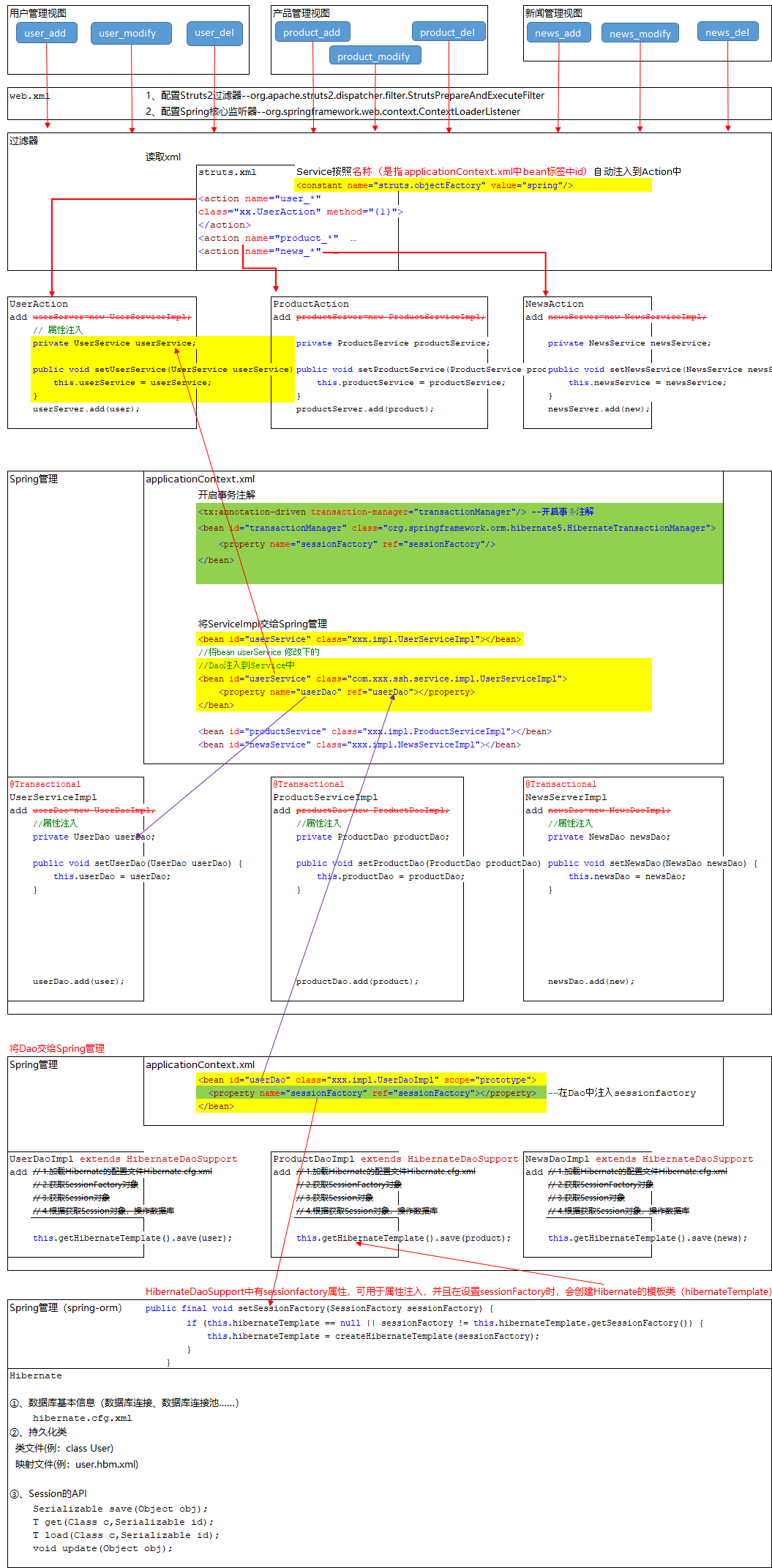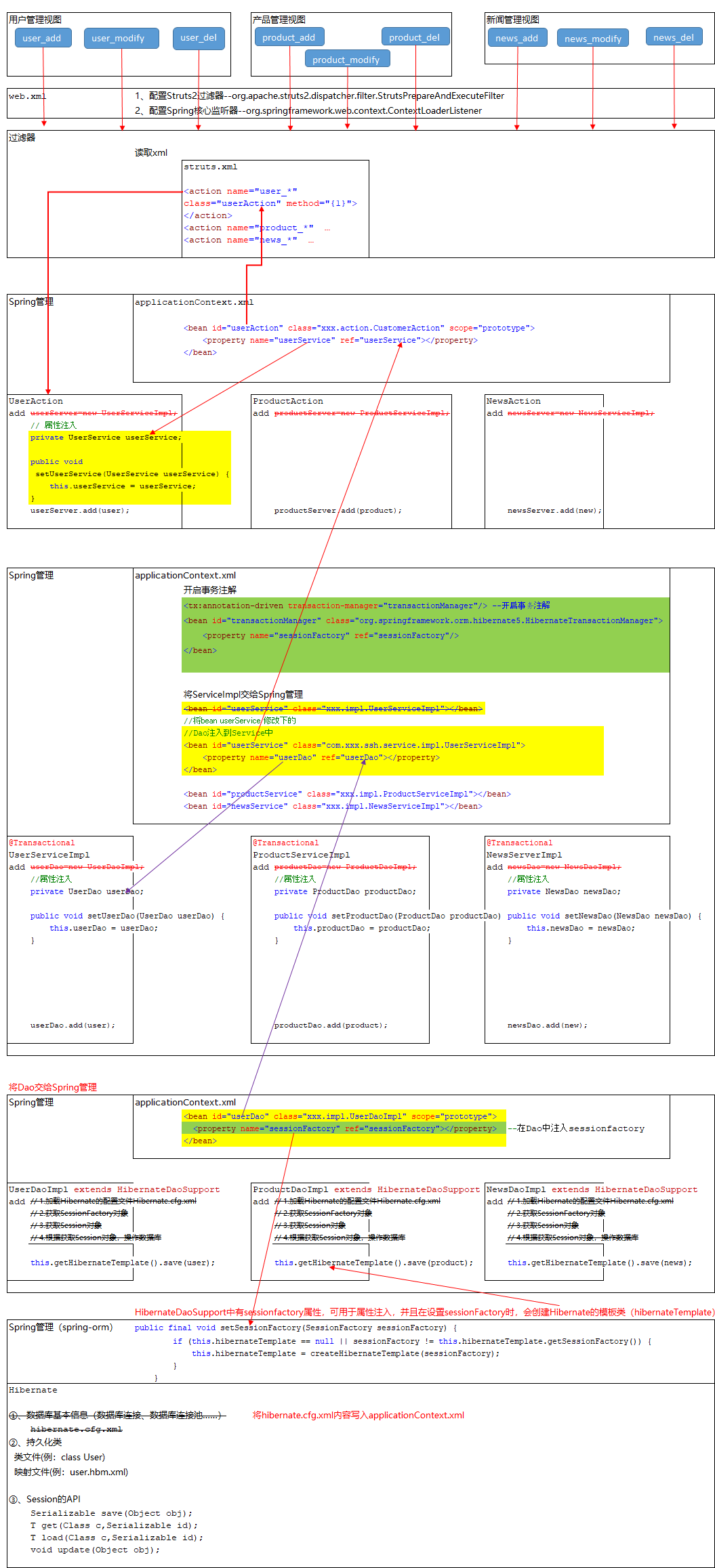一、SSH:Struts2、Spring、Hibernate三个框架的整合。
Struts2:模型与视图的数据交互
Spring:一个分层的SE/EE一站式轻量级开源框架
1、方便解耦,简化开发
通过Spring提供的IOC容器,可以将对象之间依赖关系交由Spring控制,以降低程序过度耦合。
2、AOP编程的支持
3、声明式事务的支持
4、方便集成各种优秀框架
Hibernate:是一个开放源代码的ORM(对象关系关系映射)框架
ORM:Object Relational Mapping(对象关系映射)。将Java中的对象与关系型数据库中的表建立一种映射关系,从而操作对象就可以操作数据库中的表。
二、SSH整合方式
1、spring提供了一个ContextLoaderListener核心监听器加载配置文件(applicationContext.xml)
1.1、web.xml添加监听
1 <listener> 2 <!-- 配置spring-web.jar提供的监听器,此监听器 可以在服务器启动时 初始化Ioc容器。 初始化Ioc容器(applicationContext.xml) 3 1.告诉监听器 此容器的位置:context-param 2.默认约定的位置 :WEB-INF/applicationContext.xml --> 4 <listener-class>org.springframework.web.context.ContextLoaderListener</listener-class> 5 </listener>
1.2、指定配置文件(applicationContext.xml)位置
<!-- 指定 Ioc容器(就是applicationContext.xml)的位置 --> <context-param> <!-- 监听器的父类ContextLoader中有一个属性contextConfigLocation, 该属性值 保存着 容器配置文件applicationContext.xml的位置 --> <param-name>contextConfigLocation</param-name> <param-value>classpath:applicationContext.xml</param-value> </context-param>
2、所有请求都必须通过Struts2过滤器StrutsPrepareAndExecuteFilter
2.1、web.xml 添加Struts2过滤器
<!-- Struts2的核心过滤器 --> <filter> <filter-name>struts2</filter-name> <filter-class>org.apache.struts2.dispatcher.filter.StrutsPrepareAndExecuteFilter</filter-class> </filter> <filter-mapping> <filter-name>struts2</filter-name> <url-pattern>/*</url-pattern> </filter-mapping>
3、Spring整合Hibernate
了解HIbernate的配置文件(hibernate.cfg.xml和类名.hbm.xml--类和数据表的映射关系),其具体作用,Spring如管理
hibernate.cfg.xml(主要配置session-factory节点,其内容是数据库相关配置信息,其作用负责初始化Hibernate)
<?xml version="1.0" encoding="UTF-8"?> <!DOCTYPE hibernate-configuration PUBLIC "-//Hibernate/Hibernate Configuration DTD 3.0//EN" "http://www.hibernate.org/dtd/hibernate-configuration-3.0.dtd"> <hibernate-configuration> <session-factory> <!-- 连接数据库基本参数 --> <property name="hibernate.connection.driver_class">com.microsoft.sqlserver.jdbc.SQLServerDriver</property> <property name="hibernate.connection.url">jdbc:sqlserver://localhost:1433;databaseName=HibernateDB;</property> <property name="hibernate.connection.username">sa</property> <property name="hibernate.connection.password">AAA@111</property> <!-- 配置Hibernate的方言 --> <property name="hibernate.dialect">org.hibernate.dialect.SQLServer2008Dialect</property> <!-- 可选配置start --> <!-- 控制台打印sql语句 --> <property name="hibernate.show_sql">true</property> <!-- 控制台打印sql语句 格式化--> <property name="hibernate.format_sql">true</property> <property name="hibernate.hbm2ddl.auto">update</property> <!-- 事务隔离级别 1-Read uncommitted 2-Read committed 4-Repeatable read 8-Serializable --> <property name="hibernate.connection.isolation">2</property> <!-- 可选配置end --> <!-- 配置C3P0连接池 --> <property name="connection.provider_class">org.hibernate.connection.C3P0ConnectionProvider</property> <!--在连接池中可用的数据库连接的最少数目 --> <property name="c3p0.min_size">5</property> <!--在连接池中所有数据库连接的最大数目 --> <property name="c3p0.max_size">20</property> <!--设定数据库连接的过期时间,以秒为单位, 如果连接池中的某个数据库连接处于空闲状态的时间超过了timeout时间,就会从连接池中清除 --> <property name="c3p0.timeout">120</property> <!--每3000秒检查所有连接池中的空闲连接 以秒为单位--> <property name="c3p0.idle_test_period">3000</property> <!-- 配置映射 --> <mapping resource="com/xxx/ssh/domain/Customer.hbm.xml"/> </session-factory> </hibernate-configuration>
sessionFactory 作用:用于管理Hibernate会话(session)的对象,你可以把sessionFactory当成里面有一个DataSource;这个对象创建了,hibernate才真正和数据库连接上了。SessionFactory是线程安全的,并且创建和销毁需要消耗比较大的资源,所以整个应用里面针对一个数据库只需要一个SessionFactory;
public void demo1() { // 1.加载Hibernate的配置文件Hibernate.cfg.xml // 1.1.属性文件加载 Configuration configuration=new Configuration().configure(); // 2.获取SessionFactory对象 类似JDBC连接池 SessionFactory factory=configuration.buildSessionFactory(); // 3.获取Session对象 类似JDBC中Connection Session session=factory.openSession(); // 4.开启事务(Hibernate版本5不用手动开启事务,要兼容版本3需要手动开启事务) Transaction transaction=session.beginTransaction(); // 5.编写代码 Customer customer=new Customer(); customer.setCust_name("zhang"); session.save(customer); // 6.提交事务 transaction.commit(); // 7.资源释放 session.close(); }
通过以上代码,可以知道操作数据库,就必须获取Session对象,Session对象是SessionFactory对象创建,SessionFactory对象是通过加载配置hibernate.cfg.xml,生成配置文件对象,并通过此对象创建SessionFactory,所以Spring想要整合Hibernate就需要hibernate.cfg.xml配置文件,再看hibernate.cfg.xml配置文件内容都是在session-factory节点下配置。
Spring管理HIbernate配置文件两种方式:
方式一:applicationContext.xml中加载hibernate.cfg.xml文件
<bean id="sessionFactory" class="org.springframework.orm.hibernate5.LocalSessionFactoryBean"> <!-- 加载hibernate配置文件 --> <property name="configLocations" value="classpath:hibernate.cfg.xml"/> </bean>
方式二:在applicationContext.xml中直接配置hibernate.cfg.xml文件中的内容
jdbc.properties文件内容
jdbc.driverClass=com.microsoft.sqlserver.jdbc.SQLServerDriver
jdbc.url=jdbc:sqlserver://localhost:1433;databaseName=HibernateDB;
jdbc.username=sa
jdbc.password=AAA@111
applicationContext.xml添加内容,最终目的:管理sessionFactory对象。
<!-- 引入数据库连接属性文件 --> <context:property-placeholder location="classpath:jdbc.properties"/> <!-- 配置C3P0连接池 --> <bean id="dataSource" class="com.mchange.v2.c3p0.ComboPooledDataSource"> <property name="driverClass" value="${jdbc.driverClass}"/> <property name="jdbcUrl" value="${jdbc.url}"/> <property name="user" value="${jdbc.username}"/> <property name="password" value="${jdbc.password}"/> </bean> <bean id="sessionFactory" class="org.springframework.orm.hibernate5.LocalSessionFactoryBean"> <!-- 注入连接池 --> <property name="dataSource" ref="dataSource"/> <!-- 配置Hibernate的相关属性 private Properties hibernateProperties;对应使用<props>标签 --> <property name="hibernateProperties"> <props> <!-- 方言 --> <prop key="hibernate.dialect">org.hibernate.dialect.SQLServer2008Dialect</prop> <!-- 控制台打印sql语句 --> <prop key="hibernate.show_sql">true</prop> <!-- 控制台打印sql语句 格式化--> <prop key="hibernate.format_sql">true</prop> <!-- 自动创建修改表 --> <prop key="hibernate.hbm2ddl.auto">update</prop> </props> </property> <!-- 配置映射 --> <mapping resource="com/xxx/ssh/domain/Customer.hbm.xml"/>
</bean>
以上配置完成后,代码中就可以通过继承HibernateDaoSupport,其内部有setSessionFactory方法回去创建HibernateTemplate对象,可以使用此对象中的方法操作数据库了。
public class CustomerDaoImpl extends HibernateDaoSupport implements CustomerDao { @Override public void save(Customer customer) { System.out.println("CustomerDaoImpl的save方法执行了"); this.getHibernateTemplate().save(customer); } }
在操作数据库时正常是要使用到事务管理器的
<!-- hiberntae事务管理器,也需要将sessionFactory加进来,从hibernate中得代码就可以看出来,事务也是由sessionFactory获取来的--> <bean id="transactionManager" class="org.springframework.orm.hibernate5.HibernateTransactionManager"> <property name="sessionFactory" ref="sessionFactory"/> </bean>
4、Spring整合Struts2
Struts2配置文件(struts.xml),Struts2作用是什么,Spring如何管理Struts2
struts.xml:要配置Struts项目的一些全局的属性,用户请求和响应Action之间的对应关系,以及配置Action中可能用到的参数,以及处理结果的返回页面。
方式一:Action由Struts2管理
<?xml version="1.0" encoding="UTF-8" ?> <!DOCTYPE struts PUBLIC "-//Apache Software Foundation//DTD Struts Configuration 2.5//EN" "http://struts.apache.org/dtds/struts-2.5.dtd"> <struts> <!--
Struts2的action由Spring来负责进行实例化
只有设置此常量才会引发struts.objectFactory.spring.autowire = name 生效,
让Action按照名称自动注入Service
--> <constant name="struts.objectFactory" value="spring"/> <package name="crm" extends="struts-default" namespace="/"> <global-allowed-methods>regex:.*</global-allowed-methods> <action name="customer_*" class="com.xxx.crm.web.action.CustomerAction" method="{1}"> <result name="saveUI">/jsp/customer/add.jsp</result> </action> </package> </struts>
applicationContext.xml需要配置Service
<bean id="customerService" class="com.xxx.crm.service.impl.CustomerServiceImpl"> <property name="customerDao" ref="customerDao"/> </bean>
使用代码:
// 属性注入 private CustomerService customerService; public void setCustomerService(CustomerService customerService) { this.customerService = customerService; } public String save() { System.out.println("CustomerAction中的save方法执行了"); customerService.save(customer); return NONE; }

方式二:Action由Spring管理,Hibernate的配置交由Spring管理
struts.xml
<?xml version="1.0" encoding="UTF-8" ?> <!DOCTYPE struts PUBLIC "-//Apache Software Foundation//DTD Struts Configuration 2.5//EN" "http://struts.apache.org/dtds/struts-2.5.dtd"> <struts> <package name="bean" extends="struts-default" namespace="/"> <action name="customer_*" class="customerAction" method="{1}"></action> </package> </struts>
applicationContext.xml部分内容:Action是多例的
<bean id="customerAction" class="com.xxx.ssh.web.action.CustomerAction" scope="prototype"> <property name="customerService" ref="customerService"></property> </bean> <bean id="customerService" class="com.xxx.ssh.service.impl.CustomerServiceImpl"> <property name="customerDao" ref="customerDao"></property> </bean> <bean id="customerDao" class="com.xxx.ssh.dao.impl.CustomerDaoImpl" scope="prototype"> <property name="sessionFactory" ref="sessionFactory"></property> </bean>
SSH图解

总结:
1、Spring可以管理Action、Service、Dao、Hibernate
2、两端对象都交给Spring管理需要手动完成属性注入